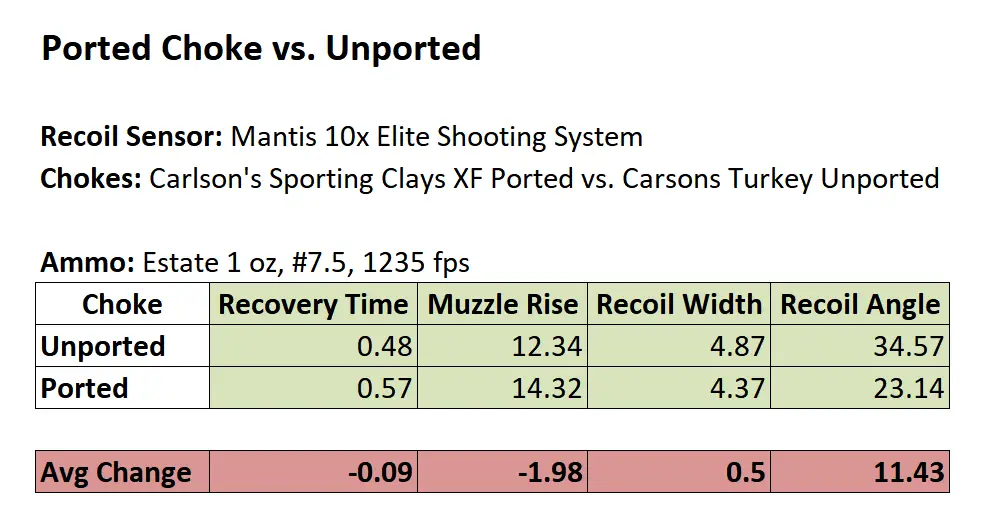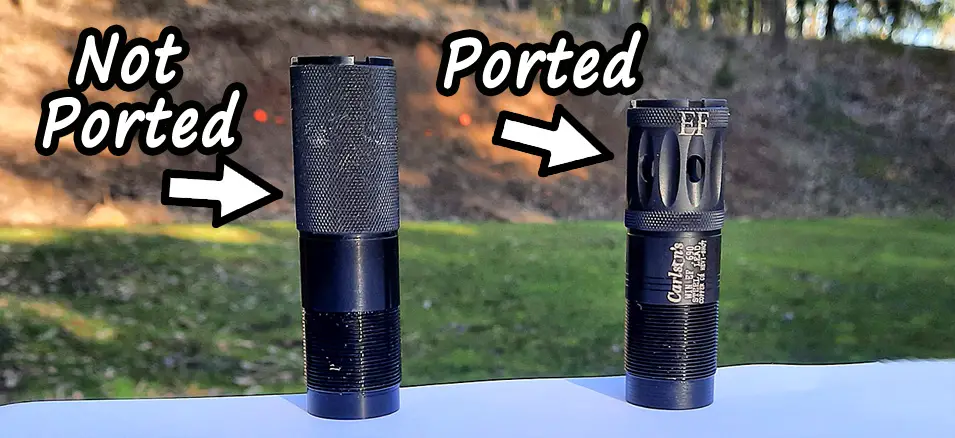The internet has split opinions on whether ported choke tubes reduce felt recoil in a shotgun. The debate is fierce and there are strong arguments on both sides. I will give an overview of the some of the key points here. But instead of weighing the merits of various opinions, I got my hands on a recoil meter, some ported and un-ported choke tubes, various kinds of ammo and decided to put this to the test once and for all.
I studied and searched for some time to find an objective way to measure this phenomenon and get some real data on the subject. I was shocked at how little there is written or published on the subject and how hard it is to objectively measure recoil in even quasi-scientific ways. But after much research, I found a way to examine this.
I should state up front, I have no vested interest in whether or not choke tubes effect recoil. I only want to know the truth so I can know what to buy and shoot for myself. And I figured other people might want to know as well, hence the study, videos, and articles I’ve published. Recoil is a big subject when it comes to hunting, to go deep on that subject in general, check out my podcast episode: What Hunters Need To Know About Recoil.
Why Might Ported Chokes Help?
The idea is that the porting on a choke tube enables gas to vent out perpendicular to the barrel, so it does not exit the muzzle of the barrel. The less gas escaping through the muzzle, the less felt recoil there will be. That is a fair hypothesis, it makes sense, and the physics line up. The big question is whether or not this effect is large enough to make any measurable difference. And that is the main question I set out to answer with these experiments.
There are some other hypotheses though. Some expect the porting in the choke to reduce muzzle rise and recoil similar to a muzzle brake. Ported muzzle breaks are designed in such a way that aggressively cut channels angle escaping gas upward and toward the shooter thus creating a downward and forward force which mitigates rear pushing felt recoil. Muzzle breaks are real, they really do this, and they can have a major impact on how a gun handles.
But choke tubes are not muzzle breaks. Their porting is to the sides, not rearward or on top. They create no downward or forward forces. They screw into the end of the barrel and their ports go all the way around uniformly. A choke tube will not produce the benefits of a muzzle break.
Muzzle breaks are also most often used on rifles to mitigate recoil and muzzle rise with high velocity loads. In these applications the cartridge is producing much higher pressures in the chamber and barrel than a shotgun will, and those gases are more swiftly and forcefully working to escape which enhances the impact of ported muzzle breaks.
Ports = Louder
Regardless of any impact on recoil, an unintended consequence of ported choke tubes is an increase in the volume level of the shotgun behind and beside the muzzle. The ports do let gas vent out perpendicular to the barrel and with that gas comes sound. A ported choke can significantly impact the volume of each shot from the perspective of the shooter and those nearby. This amplifies an already significant danger.
Shooting and hunting without ear protection is dangerous. Every shot can take a toll on your hearing. Add a ported choke and the risk becomes greater still with every shot. People often shrug this off when they are hunting, as if it is just part of the cost of going into the woods. But that is just not true. If you do not protect your ears, you will pay for it. You will pay a little bit now and a lot over time. You will also likely pay for it in ways you do not realize. Often hearing loss is accompanied by ringing and other endless painful sounds. It also increases your odds of developing various conditionals like dementia by 300%.
It boggles my mind that people flippantly hunt without ear protection, especially today when quality digital hearing protection is available that both protects your hearing and enables you to hear game animals better and more clearly. This is a big subject that I won’t take the time to cover here, but to go further check out my article: Tetra AlphaShield Review – Hearing Protection for All Hunters.
Actual Recoil vs. Felt Recoil
There is often confusion between actual recoil and felt recoil. Actual recoil is the force generated by the cartridge, it is real, mathematical, and inflexible in a sense. Felt recoil is how the recoil is experienced by the shooter. Additional factors come into play that can lessen the perceived effect or intensity of felt recoil. Diverting gasses to create a counter force like with the muzzle break is one way this can occur.
Adding weight to the shotgun also slows down the recoil impulse, allowing it to be experienced over more time and thus with less severity. A padded but plate on the stock has a similar effect. The action of the shotgun can also impact the distribution and timing of the recoil impulse some as well. You can find more about that in my article: Do Semi-Auto Shotguns Have Less Recoil REALLY?
If choke tubes do have an effect on recoil, it would be with respect to the felt recoil, potentially diverting gas to slow down the reward acceleration of the shotgun into the shoulder of the shooter.
So How Do You Test Chokes & Recoil?
Well, for years people would change choke tubes and take a few shots to see if they can feel any difference. You can imagine how that approach would lead to different opinions. To test it, we need an objective and quantitative way to measure recoil. After much research I came upon the Mantis x10 Elite Shooting System. The Mantis is a training sensor that you can attach to the end of your barrel that enables you to measure the effects of recoil. It gives measurements for shot recovery time, muzzle rise, and recoil width among other things.
I reached out to Mantis and asked if I could borrow one of their sensors for this testing and they were very kind to give me one. The Mantis really does ALOT of other things for training, trigger control, accuracy, etc. What I used it for with this testing is about 5% of what is capable of and designed to do. The full Mantis system is worthy of its own review, which I made do down the road.
I then attached the Mantis to my shotgun and got two different types of ammunition, Remington Sporting Clays target loads with 1 1/8 oz at 1200 fps and some heavy waterfowl hunting ammo, the BOSS Copper Plated Bismuth #1 with 1 5/8oz at 1350 fps. BOSS kindly gave me the ammo I used for this testing. I fired a 3 shot string with each load using an extended un-ported choke and then fired them in an extended ported choke. The Mantis tracks and averages the results of each shot and each string of shots. I then compared the ported vs. un-ported data from each test group. You can see the entire test video here:
Preliminary Results
Having never used the Mantis before this test and making up the methodology as I went, I encountered a few problems with my initial test. The individual shots and shot strings produced wildly inconsistent results. I found that good data was incumbent upon me to hold the shotgun in the same exact position with the same grip every time. I also found that a single string of three shots was not enough to produce robust data. I had to keep shooting more strings off camera to figure out what my problems were and then shoot more shots to get enough data to get results.
It was messy research and by the end I was weary and bruised. The BOSS #1 Hammers, as they are called, are a late season goose load that produces so much recoil that every shot was painful for someone with my build and t-shirt. They hit as hard as heavy turkey loads. After firing most of a box, I was anything but consistent. People often do not realize that just by adding a little bit of shot you can significantly increase the amount of recoil I ended the test with the conclusion that IF ported choke tubes made any difference, it was not much. I then began planning for a better way to test this.
Take 2 – The REAL Test
I devised a new research methodology where I would use only one ammunition, regular target ammo that I could easily handle and fire many shots of consistently. I then shot 25 shells with each choke tube to get a much larger data set, one box of ammo per choke tube. I focused very intensely on my shooting form and grip to be as consistent as possible. Thankfully this was much easier with regular shells. I easily shoot 125 or more in a day of sporting clays so doing a test with 50 was not taxing at all.
The data from this second test was much more consistent, reliable, and easy to interpret. Here is the full breakdown:

In short, the ported choke had less than 1 tenth of second worse recovery time, 1.98 degrees more muzzle rise and half a degree less recoil width. Put plainly, the differences were so small that they could have been rounding error. The ported choke did ever so slightly better in some areas and ever so slightly worse in others. There was no functional difference to speak of. Both chokes were practically identical when it came to impact on recoil. You can watch my third and final test video here as well. This takes the testing one step further and brings this series of tests to conclusion:
Conclusion & Recommendations
So the bottom line is that this myth is busted. Ported choke tubes have no significant impact on felt recoil. That isn’t opinion, feelings, or reasoning, it is real data. I can also say that subjectively, as the shooter, I could not detect any difference in recoil myself. Both chokes seemed identical to me across all of the different testing scenarios, good and bad.
My conclusion then is to stick with non-ported choke tubes in those situations where equally patterning options exist in both. Some choke tubes only come ported for some reason. I will not discard a high performing ported choke in order to save a few decibels of volume, but I now prefer to search out non-ported choke tube options first.
Be sure to listen to The New Hunters Guide Podcast and check us out on YouTube.
Till next time. God bless you, and go get em in the woods!
George Konetes Ph.D. – Founder and Host of the New Hunters Guide.
The New Hunters Guide is simply what George wishes he would have had when learning how to hunt; a single place to get practical hands on knowledge about different kinds of hunting, gear, strategy, and tips that can improve your comfort and fun factor in the woods.
As a note, Carlson’s gave me with these chokes, BOSS gave me ammo, and Mantis gave me this sensor to do this testing. Thanks to them for their support.

